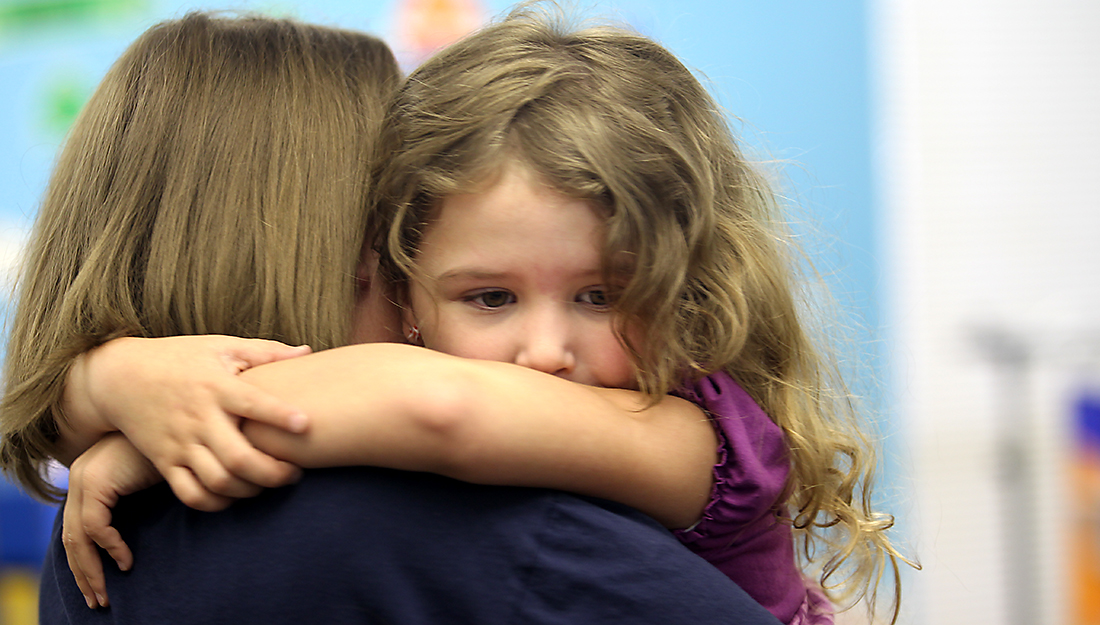You Asked: How can you ease separation anxiety in children?

You have seen the outburst. Mom or dad walk the child to the classroom, say their goodbyes to leave for the day and the child loses it, sobbing and almost terrified to be apart from a parent. Although some emotion is to be expected on that first day of pre-kindergarten, if that type of behavior happens regularly, the child might have separation anxiety.
“Separation anxiety is the fear or anxiety surrounding a person’s separation from their home, a primary caregiver or other significant relationship,” said Kathleen Roblyer, DNP, DMIN, ARPN, PMHNP-BC, a clinical assistant professor at the Texas A&M College of Nursing.
It is estimated that 6.6 percent of the population will experience separation anxiety at some time in their lifetimes. It is the most common anxiety disorder in children under 12 years old and, in a given year, it is estimated that approximately 4 percent of children are affected. Adults can also experience separation anxiety; however, the rate declines in adulthood to approximately 1–2 percent.
Cause
There is no certain cause for separation anxiety. “Sometimes it occurs following a traumatic event, such as hospitalization of the child or caregiver, death of a family member, a move or a natural disaster,” Roblyer said. “However, there is not necessarily a precipitating incident. It may be a learned response or there may be a family trait of predisposition to anxiety.”
It is a normal stage of development for a child 8–24 months old to form strong attachments with family members or a primary caregiver and begin to differentiate between them and people outside of the family. Some separation anxiety may persist until 3–4 years old. If the child is 4–6 years old or older and still shows severe dependence, anxiety and fear of separation that impairs normal functioning and persists longer than a month, the child should be evaluated.
Symptoms
Symptoms of separation anxiety in children may include:
- worrying about the safety of self or others
- difficulty leaving home due to fear of something happening to the primary caregiver
- refusal to go to school
- reluctance to participate in activities outside of the home
- inability to be alone
- nightmares about separation
- difficulty sleeping away from home
- physical symptoms such as headache, diarrhea, nausea or palpitations
“The symptoms are more than simple homesickness,” Roblyer said. Even when at home with a parent or caregiver, the child might seem overly clingy, follow the adult around or want to sleep in bed with the adult for comfort and reassurance. The child’s behavior becomes focused on anticipating and preventing separation. “When these behaviors occur, it is time to pay attention,” she added. “When they persist longer than four weeks and affect the child’s functioning, it is time to get help.”
Treatment
A health care professional can determine whether established criteria are met for a diagnosis of separation anxiety disorder. Prompt treatment is especially important if the child is having suicidal thoughts or if other mental health problems are present.
A pediatric or family health care provider can do an initial assessment, rule out medical problems, give advice and refer if necessary. “If the child’s symptoms are so severe that they impair functioning, a mental health professional can make a diagnosis, rule out other mental health problems and provide age-appropriate talk therapy,” Roblyer said. “Cognitive behavioral therapy and family therapy are very effective for children.” Sometimes medication is also used, typically an antidepressant with an indication for safe use in children. In this case, a referral may be given to a provider specializing in child-adolescent psychiatry.
Prevention
There is no known way to prevent separation anxiety, so adults should avoid blaming themselves or the child. “However, one of the most important things that parents or caregivers can do to raise healthy children is to keep themselves healthy,” Roblyer said. If an adult close to the child has an untreated anxiety disorder, other mental health problems or complex medical problems, the child’s anxiety may be learned behavior or a protective response. “Children take their cues from the adults in their lives,” she added. “When an adult is calm, confident, reassuring and loving, that builds a sense of security in the child.”
Pediatric or family providers typically give anticipatory guidance in well-child appointments. Parents or caregivers can use this information to understand normal development, ask questions and develop strategies for helping their child progress from one developmental stage to the next. “Listening to the child, acknowledging fears, offering reassurance and affirming their progress is always helpful,” Roblyer said. “There is no guarantee, of course, that this will prevent separation anxiety, but good parenting improves outcomes for any child.”
Media contact: media@tamu.edu


